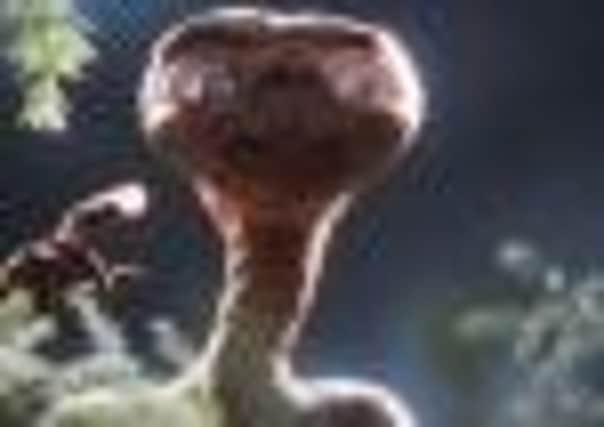Will humans ever be able to phone ET’s home for real?


Thirty years ago, Steven’s Spielberg’s blockbuster ET – The Extra-Terrestrial broke box office records around the globe. With its story of a young boy who befriends a blanket-wrapped extraterrestrial, it set millions dreaming of their own personal alien.
Taking $800m at cinemas worldwide – the equivalent of almost $2.5bn today – movie history was made. But three decades after ET phoned home, is the film, as some assert, still the greatest sci-fi picture ever – and how much closer are we to finding a real ET?
Advertisement
Hide AdAdvertisement
Hide AdBack in ’82, critics acclaimed Spielberg’s timeless story of friendship and it has even ranked as the greatest science fiction film ever in one major online survey. Scientists and film buffs may be divided about ET and its uplifting message of friendly life existing elsewhere in the cosmos. Some remain optimistic, though, that a real-life ET will make contact thanks to giant leaps in scientific know-how in recent decades.
Spielberg is said to have based the bicycle-riding being who befriends 10-year-old earthling Elliott on his own imaginary friend, invented as a comfort after his parents’ divorced. It was said that the model of ET in part mimicked Albert Einstein and in part a pug dog.
The film was shot in California on a budget of $11m, and premiered to a standing ovation at the Cannes Film Festival in May 1982. It even surpassed Star Wars to become the highest-grossing film of all time – a record it held for 10 years.
But was ET really extra-special?
Dr Stephen Dorril of the University of Huddersfield, a film lecturer and director of the Holmfirth Film Festival, says: “I have always found ET to be nauseating and a good example of why Steven Spielberg is such an awful film director. It is a symptom of the infantilisation of modern culture, where people proudly act as if they are back in the sandpit and reject any idea of being an adult. It is fine for children, but even at that level it is full of the rotting saccharine and a deep sentimentality which, even Spielberg admits, prevent his films from ever being considered truly great. Better to watch The Red Balloon, which remains a film of real childhood wonderment.” Wounding words indeed.
Advertisement
Hide AdAdvertisement
Hide Ad“My principal memory of ET is as a nine-year-old growing up in South London,” says Dr Leo Enticknap, lecturer in cinema at the University of Leeds. “I suspect ET was one of the first, if not THE first, Hollywood film to have been distributed widely in this country on pirate videotapes (VHS). I do remember that it was a point of honour and a significant status symbol for children in my class at school to have seen ET on a pirate tape before the date of its cinema release.”
Michael Harvey, curator of cinematography at the National Media Museum, Bradford, says: “... it’s a classic Spielberg production, very accomplished and, as often the case, over-sentimental in parts. It’s always been somewhat coloured for me by the person who asked the question that totally undermines the plot – why, if ET manages to fly at the end of the film, can he not do that when he is abandoned and chased by the heavies at the start?”
Seth Shostak, senior astronomer at the SETI Institute in California, is convinced an ET of sorts is really out there, and says science has taken great strides in the search for such life since 1982.
“Frankly, one ought to admire little ET for coming all the way from the Andromeda Galaxy – a trek of two million light-years – just to pick some plants and play with the kids. Not even the Starship Enterprise was up to that kind of long-haul venture.
Advertisement
Hide AdAdvertisement
Hide Ad“Today we know things that were still speculative then, and in particular that the majority of stars have planets.
“Indeed, a good estimate for the tally of planets in our own galaxy (and in ET’s galaxy too) is about one million million. So there could be plenty of intelligent life out there – and plenty of plants to collect.
“Note that ET is a ‘good’ Hollywood alien: he looks like a child. Big eyes, wrinkled forehead, and small body. Most cinema aliens are malevolent, ugly, and interested only in wreaking havoc and destruction.
“But of course, that makes for interesting stories. ET’s exceptional. The one thing that’s inadvertently right about the film? ET’s society knew about our chlorophyll.
“There’s been oxygen in Earth’s atmosphere for several billion years now, the result of photosynthesis. And that oxygen could be detected by any aliens wielding a big enough telescope.”